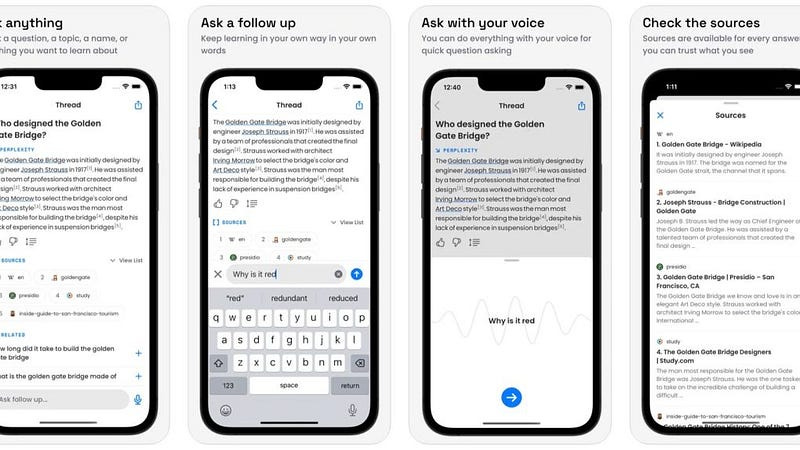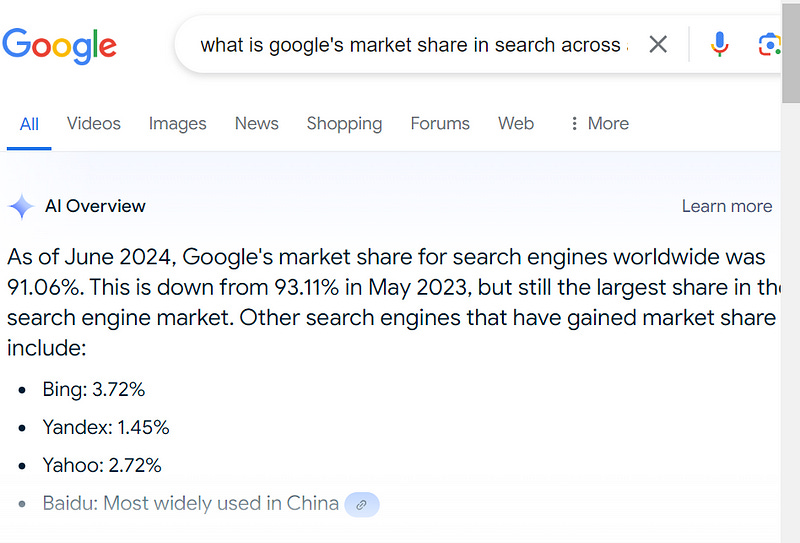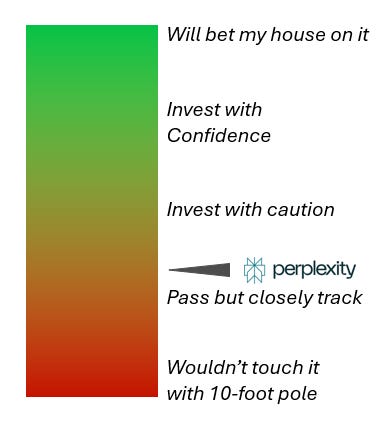Perplexity: How AI is Challenging Google's Monopoly on Search
Artificial Intelligence and Search
Around 3 months ago, I removed Google Chrome from my iPhone’s dock, you know, the little 4-apps tab that floats on the bottom of your phone.
It was a small action, but it represented a pivotal moment.
Over the years, I’ve seen countless apps come and go. Supercell games were replaced by Microsoft 365, new categories like Tinder and Hinger emerged, and once-hot apps like Clubhouse and Bereal disappeared.
Despite the turmoil, some things I thought would never change.
The 4 apps on my dock (Messages, Calls, Email, and Chrome) were seemingly an unmovable part of my phone’s foundation— until recently.
It was the weirdest feeling replacing Chrome. When I pressed my finger on the screen and saw the little icon tremble, I felt like I was orchestrating a coup.
But alas, sometimes regime changes are necessary. The new rulers are often better suited to the new environment and better represent the changing needs.
Just like that, the empty throne left by Chrome was quickly filled.
In its place, a black and white icon wielding the power of artificial intelligence placed itself amongst the prestigious tribunal of Arthur’s iPhone.
Vowing to disrupt Google’s monopoly and change the way we search for information, Perplexity AI arrived.
What is Perplexity AI?
Perplexity is an AI-powered search company.
The company is founded on the belief that our current way of searching for information is broken.
Instead of the traditional search model of typing in keywords and finding links that contain those keywords, Perplexity AI answers questions through a conversational interface using Large Language Models (LLMs).
No more accidentally clicking on overly SEO-optimized ads, no more opening 5-10 links to find the best source, and no more scrolling through pages of search results to find the information you need.
Instead, imagine you are talking to the world’s most knowledgeable person with all the available information at their fingertips — this is like asking questions on Perplexity. In response, it will generate a direct, detailed, and sourced answer.
If you don’t like the answer, just follow up and ask it to tweak the answer instead of thinking about what new keywords you need to type into Google.
Speaking from personal experience, Perplexity has completely revolutionized the way I search for information.
I now spend far less time finding info, getting much more direct answers to my questions, and trusting that the answers are high quality.
From a technical standpoint, Perplexity AI combines natural language processing, information retrieval, deep learning, and web crawling technologies to generate its responses. It also uses a combination of LLMs, including GPT4.0, Claude 2, and its own LLM (built on top of open-source projects like LLaMA-2 and Mistral 7B).
Unlike ChatGPT, Perplexity is not made to be creative. Admittedly, it is not great at conversations and serves as a poor therapist or poet.
However, this is designed on purpose. Perplexity’s goal is simply finding and presenting information. By reducing creativity and adding citations, it is far less likely to hallucinate and provide inaccurate information.
Like most consumer AI companies, Perplexity’s main product is a free conversational answer engine chatbot. However, there are a few different versions of the product:
Perplexity Pro: $20/month for individual users. Allows users to choose between which LLM to use, unlimited file uploads, up to 600 Pro Searches (more in-depth) per day, and visualize up to 50 answers using Playground AI or DALL-E.
Enterprise Pro: Enterprise version of Pro, with added features like increased data privacy, improved security (SOC2 certified), user management, SSO, etc.
Perplexity API (pplx-api): Allows developers to integrate Perplexity into their applications and charge based on usage.
Perplexity was recently founded in 2022. With the goal of harnessing the power of LLMs to make knowledge more accessible, Aravind Srinivas (CEO), Denis Yarats (CTO), Johnny Ho (CSO), and Andy Konwinski (President with a GREAT beard) built a super team and created Perplexity AI.
Honestly, this team can probably walk into any VC’s office and raise money. With impressive work experience at companies like OpenAI, DeepMind, Quora and Databricks (which Andy co-founded) and a deep passion for AI and LLM, this is truly one of the best founding teams that ever walked through Sand Hill Road.
In just two years, Perplexity AI has reportedly attracted ~10m MAUs, with 52.4m visits in February 2024. Throughout 2023, Perplexity served more than 500m search queries and has grown to ~170m per month (but still merely ~0.1% of Google’s 1.2tn average annual search query)
Lastly, Perplexity raised a $73.6m Series B in Jan’24 at a $540m valuation led by IVP. In Mar ‘24, the company raised $62.7m at a $1bn valuation, which was led by Daniel Gross with participation from Druckenmiller, Bezos, Naval, Elad Gil, NEA, etc. (wow)
How is Perplexity Positioned?
Perplexity spans across 2 industries: Search and AI.
The global search engine market size is valued at roughly US$185bn in 2022 and is expected to grow to $500bn+ by 2032 (~11% CAGR).
Looking at the current market, Google is a monopoly that dominates ~90% of the market across all platforms and reaches 95% on mobile. In a very, very distant second place is Bing, which holds a market share of roughly 3.2%.
It is worth noting that Google is also trying to play the AI angle by using LLMs to generate an overview whenever users search for an answer.
However, I’ve found these answers to be far less accurate and less sourced, lack mechanisms for effective follow-ups, and are weirdly positioned in a browser above many linked answers. Overall, it's a much poorer UX than Perplexity.
Furthermore, Google will have an extremely hard time pushing this model to its customers because it will mean a complete revamp of its revenue model away from the world of links and SEOs.
The second market for Perplexity is AI.
As the hottest industry currently, Statista estimates AI to be worth US$184 billion in 2024. It also projects an incredibly fast CAGR of 28.4% until 2030, reaching US$826bn.
Perplexity will certainly benefit from this rapid growth — its technology will get better as the underlying LLMs improve, investor dollars will flow rapidly into the industry, and consumers will have an appetite for trying new products.
However, it isn't without limitations.
If other AI companies (mostly LLM creators) build something similar to AGI or simply reduce model hallucinations, they may pose a serious threat to Perplexity since they can also retrieve information online accurately.
These companies have a massive advantage from a capitalization perspective as investors are betting heavily on LLMs (e.g., OAI raised $14bn+, Anthropic $1.6bn, Cohere $450m, Google is well… Google).
If these models meaningfully improve and decrease hallucination, then it is hard to see what Perplexity’s competitive advantages will be. If that does occur, then consumers will simply just pay for a great LLM instead of LLM + Perplexity.
What I like about Perplexity
There is a lot to like about perplexity.
The team truly created a product that people use and love.
There’s a reason why it replaced Google on my iPhone dock and why I have it open the entire time I am writing this article.
From an investor’s standpoint, there are also a few things that stand out:
1. The UX of Search is Massively Improved
There no denying that Perplexity is a much better user experience than traditional search. You can get a precise answer to your question, ask follow-ups, find obscure information, see the answers’ sources, ask for analysis and synthesis, etc.
For me, Perplexity has replaced Google for 80% of my search queries other than when I want to get a deeply personal take on something specific (e.g., my favourite blogger’s travel guides or a compilation of Gordan Ramsay’s best insults).
2. Perplexity Unlocks Additional and Complex Capabilities
Perplexity doesn’t just represent a process improvement; it’s also a functional step up.
It can tap into multiple sources and perform complex comparative analysis without requiring the user to open different links manually. Unlike traditional search engines that rely on keyword matching and indexing, Perplexity can dive deeper and actually understand structure and unstructured data across mediums.
For instance, Perplexity can simultaneously pull insights from academic papers, niche forums, and news articles to provide a cohesive summary with different perspectives. It can also access specific datasets like LinkedIn to answer nuanced queries, such as identifying shared past experiences between two people.
In some ways, it functions less like a search engine and more like a high-capability executive assistant.
3. Value from AI will be Acculumated Beyond The Core
I believe that, much like in the era of the internet and PC, a lot of value will be created beyond the core infrastructures.
Currently, investors are piling money into LLMs (core infra), which will eventually face pricing pressure and become more commoditized. Furthermore, if past technology trends are of any indication, a lot of value will be created in the consumer / customer-facing application area.
Perplexity will benefit from lowing prices from LLM providers and is currently one of the best examples of consumer-facing AI applications.
4. Customer-facing AI Tools May Have High Switching Costs
It may be strange to categorize something as commoditized as Search as having a “high-switching cost.” However, I think in the world of AI, this certainly is true.
Most of us still do not trust AI- and for good reasons (e.g., hallucinations). Therefore, developing trust in the application and its answers will be crucial.
Perplexity’s first-mover advantage and sophisticated algorithm have positioned itself to be one of the most trustworthy AI tools, which makes it hard for new entrants to compete with and re-earn that trust with users.
Trust is earned, and it takes a lot of time to earn people’s trust.
What My Concerns Are
We are still in the early stages of the AI revolution, particularly AI search. As such, there are still many unknowns that Perplexity and the world will need to figure out.
1. AI Search Revenue Model Is Unclear
This is perhaps the biggest question mark that perplexes everyone (pun not intended).
The traditional search model is built on top of ad revenues by clicking links and getting websites to the top of the page. With AI, one answer is aggregated from multiple sources without redirection, which nullifies the ad-based revenue model.
Perplexity is still figuring out how to monetize its 10m MAUs, which currently only generates $20m ARR. Pro, Enterprise, and API are ways to do so, but it is very hard to imagine these being as profitable as ad-based revenue. In addition, the cost of search from LLMs is considerably higher than traditional keyword searches (10x+).
2. Advances in LLMs Might Render Perplexity Uselss:
It seems that LLMs are improving on an exponential scale, and experts in this space are very optimistic about how much better LLMs will become.
As parameters for LLMs scale from billions to trillions and training techniques like RLHF improve, the level of hallucination has already noticeably decreased. At a certain point on this growth trajectory, we can imagine that hallucinations will be largely eliminated (OAI is working hard on this).
If we are able to trust LLMs more and they become more capable, then Perplexity will need to figure out a very unique edge to convince users to pay for their services.
3. Highly Expensive Valuation on Questionable Metrics
As much as I love Perplexity, it is hard to justify its valuation.
The previous $1bn valuation was raised on ~$20m ARR, which implies a 50x EV/ARR. This is a ridiculously high multiple, even for AI. For comparison, OpenAI is in talks of raising at a $150bn valuation on a reported ARR figure of $3.4bn. While both are extremely high, Perplexity (50x) being valued at a greater multiple than OpenAI (44x) is hard to swallow.
Additionally, the ~$20m ARR is mostly generated from Perplexity Pro subscriptions. Assuming that 80% of ARR comes from Pro, this means that there are only roughly 67k annual subscribers. Unfortunately, this 0.7% free-to-paid conversion is quite abysmal. To users, Perplexity Pro might not be worth the cost of upgrading, and the company might need to explore additional sources of revenue.
Apparently, Perplexity is now seeking a new funding round that will value itself at ~$3bn. Applying that to the % of the total search market, it would mean that Perplexity will need to have ~1.6% market share (~21bn annual search queries), which makes it the 3rd largest search engine after Bing. It is currently off by 20-40x.
Obviously, valuation prices in future expectations; however, this price still seems pretty hard to justify from a fundamental basis.
Some Food for Thought
Overall, Perplexity must focus on developing more loyal users from its existing user base vs acquiring more users (more S&M and computational costs).
In part, this likely means taking less money from VCs who demand to see an increase in metrics. For VCs, it's often more money, more queries, and more users.
It’s not time for more, but time for better. Here are a couple of ideas:
Improve Perplexity Pro to Increase Paid Conversion
Frankly, Perplexity Pro kinda sucks right now.
Well, that’s actually not exactly true. Perplexity Pro is great, but so is normal Perplexity. As demonstrated by the ~0.7% paying subscribers, Perplexity Pro must offer additional value-added features.
This can be done in a couple of ways:
I recently talked to a tenured professor who told me she uses Perplexity frequently for research. Perplexity Pro should include a customization feature where you can make expert co-pilots in a particular field (e.g., Academic Copilot that sources from scientific publications, Paralegal Copilot that sources from law libraries). There should also be a feature that allows users to upload proprietary databases to further train Perplexity Pro, similar to ChatGPT.
I particularly like the photos that result from normal Perplexity searches. Perhaps the Pro version could embed videos, too. Both pre-existing ones from sources like YouTube or AI-generated ones.
Retain Customers by Creating Lock-In Features
Perplexity’s current motto is “where knowledge begins.”
I absolutely love that, and I really believe increasing and preserving knowledge should be a core mission for Perplexity.
To increase customer stickiness, Perplexity can position itself as a place to also store your knowledge. Not only will it store users’ searches in “Libraries,” it should also allow users to upload their pre-existing knowledge sources. For example, my Goodreads book list, my Google Drive, my university class notes, etc.
Perplexity can then use these sources to further train and personalize its AI. It can also pull up anything from the user’s knowledge library, so we don’t forget what we’ve previously learned. It’s really the same principle as storing files on our laptop, except now we have an AI agent that can analyze, compare and communicate those files.
If Perplexity positions itself as a knowledge library, then it can create a lock-in effect. Similar to the high retention rate we see at Dropbox, people don’t want to move their “files” once they spend a lot of energy organizing and storing them in one place.
Final thoughts and recommendation
I like to evaluate the companies on 4 key criteria: runway for growth, ability to execute, product-market fit, and defensibility.
Runway for growth: 4/5. Perplexity still currently owns a very tiny percentage of the overall search market. If this new AI-powered search becomes the new norm, Perplexity is well-positioned to capture a massive market share.
Ability to execute: 3/5. The team does seem quite strong from both a technical and S&M perspective. They have built a great product and have been very successful in raising capital. But at the same time, there are a lot more hard questions they will need to solve.
Product-Market Fit: 2/5. From a purely PmF perspective, I probably would score it higher. However, I am factoring in the lack of a clear revenue model and low number of paying customers. Perplexity has built a great (free) product that people love; however, there are still a lot of questions about its sustainability.
Defensibility: 1/5. If LLMs providers like OpenAI or Anthropic improve their models to reduce hallucinations, or if Google turns around their business model and embraces AI-driven search, then it will be very difficult for Perplexity to maintain its competitive advantages.
Overall score: 4/10 (Pass, but closely track)
Overall, I think there are just too many question marks to justify an investment into Perplexity.
Especially at such a high valuation.
In my mind, the risks I presented above are major threats to the fundamental survivability of the business
Frankly, I have not seen enough convincing propositions by the management team to address them. However, given their track record, I am sure that they will come up with some innovative solutions to address them.
Once that happens and the team makes progress on these key challenges, then it would be a great time to revisit investing in Perplexity.
In the meantime, I will continue to be a loyal user and hope that my $20/month will do its part in helping them navigate these big questions.
At the very least, Perplexity can take comfort that it will remain on my iPhone’s dock for at least the next couple of years.
P.S. This article was written with assistance from Perplexity AI.







